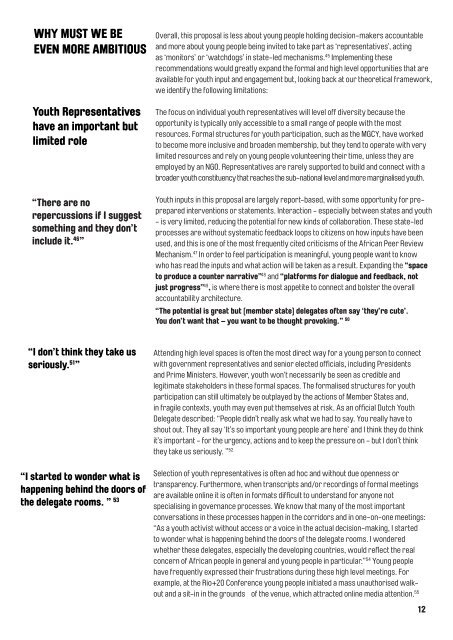FOLLOW-UP
follow-up-and-review-how-to-scale-up-ambition-on-youth-led-accountability-for-the-sdgs-pdf
follow-up-and-review-how-to-scale-up-ambition-on-youth-led-accountability-for-the-sdgs-pdf
You also want an ePaper? Increase the reach of your titles
YUMPU automatically turns print PDFs into web optimized ePapers that Google loves.
WHY MUST WE BE<br />
EVEN MORE AMBITIOUS<br />
Youth Representatives<br />
have an important but<br />
limited role<br />
“There are no<br />
repercussions if I suggest<br />
something and they don’t<br />
include it. 46 ”<br />
Overall, this proposal is less about young people holding decision-makers accountable<br />
and more about young people being invited to take part as ‘representatives’, acting<br />
as ‘monitors’ or ‘watchdogs’ in state-led mechanisms. 45 Implementing these<br />
recommendations would greatly expand the formal and high level opportunities that are<br />
available for youth input and engagement but, looking back at our theoretical framework,<br />
we identify the following limitations:<br />
The focus on individual youth representatives will level off diversity because the<br />
opportunity is typically only accessible to a small range of people with the most<br />
resources. Formal structures for youth participation, such as the MGCY, have worked<br />
to become more inclusive and broaden membership, but they tend to operate with very<br />
limited resources and rely on young people volunteering their time, unless they are<br />
employed by an NGO. Representatives are rarely supported to build and connect with a<br />
broader youth constituency that reaches the sub-national level and more marginalised youth.<br />
Youth inputs in this proposal are largely report-based, with some opportunity for preprepared<br />
interventions or statements. Interaction - especially between states and youth<br />
- is very limited, reducing the potential for new kinds of collaboration. These state-led<br />
processes are without systematic feedback loops to citizens on how inputs have been<br />
used, and this is one of the most frequently cited criticisms of the African Peer Review<br />
Mechanism. 47 In order to feel participation is meaningful, young people want to know<br />
who has read the inputs and what action will be taken as a result. Expanding the “space<br />
to produce a counter narrative” 48 and “platforms for dialogue and feedback, not<br />
just progress” 49 , is where there is most appetite to connect and bolster the overall<br />
accountability architecture.<br />
“The potential is great but [member state] delegates often say ‘they’re cute’.<br />
You don’t want that – you want to be thought provoking.” 50<br />
“I don’t think they take us<br />
seriously. 51 ”<br />
“I started to wonder what is<br />
happening behind the doors of<br />
the delegate rooms. ” 53<br />
Attending high level spaces is often the most direct way for a young person to connect<br />
with government representatives and senior elected officials, including Presidents<br />
and Prime Ministers. However, youth won’t necessarily be seen as credible and<br />
legitimate stakeholders in these formal spaces. The formalised structures for youth<br />
participation can still ultimately be outplayed by the actions of Member States and,<br />
in fragile contexts, youth may even put themselves at risk. As an official Dutch Youth<br />
Delegate described: “People didn’t really ask what we had to say. You really have to<br />
shout out. They all say ‘It’s so important young people are here’ and I think they do think<br />
it’s important - for the urgency, actions and to keep the pressure on - but I don’t think<br />
they take us seriously. ” 52<br />
Selection of youth representatives is often ad hoc and without due openness or<br />
transparency. Furthermore, when transcripts and/or recordings of formal meetings<br />
are available online it is often in formats difficult to understand for anyone not<br />
specialising in governance processes. We know that many of the most important<br />
conversations in these processes happen in the corridors and in one-on-one meetings:<br />
“As a youth activist without access or a voice in the actual decision-making, I started<br />
to wonder what is happening behind the doors of the delegate rooms. I wondered<br />
whether these delegates, especially the developing countries, would reflect the real<br />
concern of African people in general and young people in particular.” 54 Young people<br />
have frequently expressed their frustrations during these high level meetings. For<br />
example, at the Rio+20 Conference young people initiated a mass unauthorised walkout<br />
and a sit-in in the grounds of the venue, which attracted online media attention. 55<br />
12



